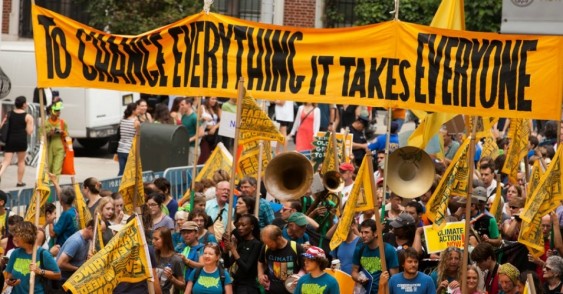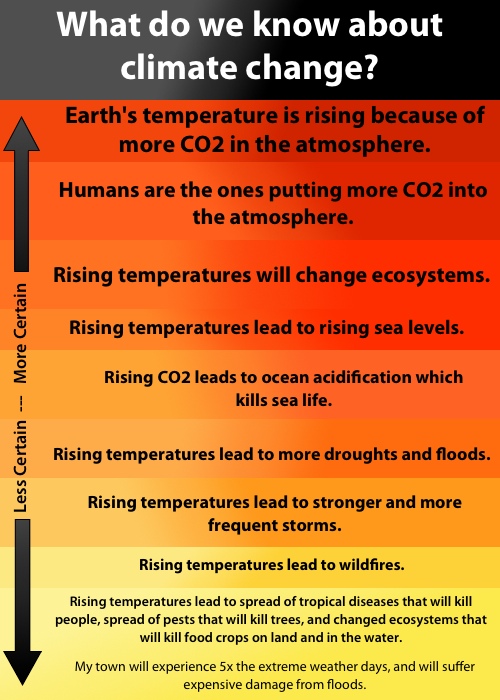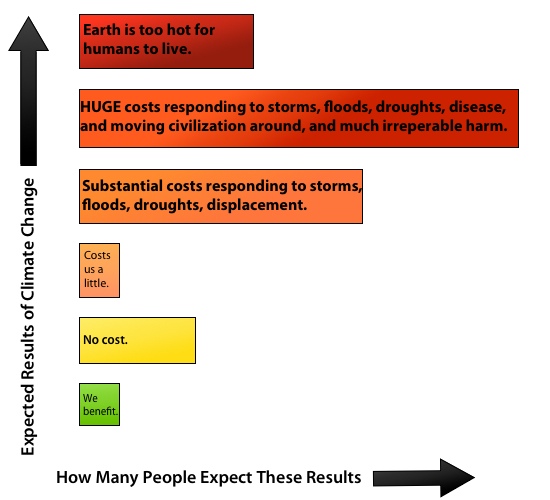The day before the People’s Climate March, the Wall Street Journal (WSJ) published an opinion piece by Steven Koonin titled: “Climate Science is Not Settled.” The title conforms to the merchants of doubt’s strategy of sowing doubt and confusion, but it is not even an accurate summary of the article. The article actually affirms that the main things almost everybody thinks of when they hear “climate science”—whether climate change is happening and whether it is caused by people—are quite settled.
Interestingly, next to the climate article was Robert Sapolsky’s always-excellent column, which this week was about insect decision-making. Apparently, a solo ant can efficiently make easy decisions, but hard decisions are better when made with the wisdom of the ant crowd. Bees faced with an unclear decision are indecisive and may refuse to decide at all. The climate article with its muddled message about how to decide to act, the WSJ’s mismatched headline peddling confusion and indecision, and the day of marches all over the world demanding that decision-makers take immediate action on climate—the conjunction of these things made me think about how we humans decide. Sometimes our stellar ability to collect and share information seems to trip us up instead of help us move forward. But I remain hopeful that we can be better deciders, like ants, not like bees.
My hope is not unfounded: countries around the world and 10 US states have already bypassed indecision, and Oregon and Washington are poised to take action. This weekend hundreds of thousands of climate marchers around the world, including thousands in Portland and Seattle, showed the people’s growing power to overcome the merchants of doubt’s poisonous whisperings.

The WSJ article held the seed of an important idea but, unfortunately, trampled it with political hogwash before the idea could sprout. The idea is this: we must accept that science can’t tell us everything, and decide the best course of action in the face of uncertainty. If science can tell us everything with certainty, then we can plug the numbers into a neat cost-benefit analysis and spit out the optimal course of action. But that one can turn out to be a really bad bet if the future isn’t what you banked on. If we accept that science can’t tell us everything, then we need to choose courses of action that are robust: they will work well in a variety of futures.
So what did Koonin have to say about decision-making in the face of uncertainty? He agreed that uncertainty is not an excuse for inaction. He warned that if we don’t take climate change seriously, “we could be caught flat-footed.” However, he still managed to leave readers with the sense that we should wait until we can collect data about the impacts of climate change before we will be informed enough to make decisions. Say what? We need to wait until climate change happens to know what will happen with climate change? Isn’t that the definition of getting caught flat-footed?
Here is a clearer way to step through the questions of what we know about climate science and what that means for taking action:
(1) What do we know about climate change?
As Koonin points out, we are very certain that climate change is happening and people are causing it (top of the chart below). As we get more granular about precise impacts and the locations of those impacts, we become less certain.

(2) What do we know about the impacts of climate change?
We can’t predict what climate change will mean for every town on earth, and no amount of information gathering will give us that kind of crystal ball. But we do have a good idea that it will be bad. We may not know in what years New York City will again be hit by a superstorm, or exactly how many feet the storm surge will be, but we know that the eastern seaboard, and other cities around the world, will be hit by storms. We know the US will be hit by more droughts, floods, wildfires, disease, and climate refugees. We know that all of this will cost money to respond to, contain, and attempt to rebuild. We know that with each subsequent disaster, we will have fewer resources for responding to the next. Here in the Pacific Northwest, we are lucky we won’t have the same debilitating impacts of other regions, but we can expect a tripling or octupling of extreme weather days, a foot of sea level rise, and a possible 78 percent increase in forests burned by wildfires.
The vast consensus is that climate change will cost us. In the chart below, the expected outcomes of climate change are arrayed with the worst at the top (earth becomes uninhabitable) and best at the bottom (we benefit from climate change). The length of the bars indicates the number of informed people who expect these outcomes, with most thinking they will be big, and some thinking they will be catastrophic. Only a few outliers think there will be no costs, or that we will actually benefit from climate change (because carbon dioxide is a life-giving substance that helps plants grow—seriously, some say that). Most argue that there will be some costs, but they disagree about how to weigh those costs against the costs of stopping climate change. Even Bjorn Lomborg doesn’t say climate change isn’t going to cost us, he just says we should focus on other things. Others argue we should let our kids and grandkids foot the bill because they will be richer than us and able to afford it. (Um: Dear Boomers, That’s not working out so well. Love, Us Millennials.)

(3) What do we know about the costs of fighting climate change?
If we are certain climate change is happening, and pretty certain it is going to be either bad or really bad for us, the next questions are: What can we do? How much will that cost? The short answer to what can we do is: price carbon, roll out more clean electricity, develop cleaner transportation options, stop wasting so much. The short answer to what will that cost is: it will be cheap or free or it will even save us money. Those are the latest estimates from the New Climate Economy Project and the International Monetary Fund (not known as a bastion of starry-eyed hippies). There are two main reasons for these exciting conclusions:
A) We can spend the same money that we would spend anyway, just on different things that reduce pollution. For example, the world is poised to spend $90 trillion on infrastructure in the next 15 years. By building new renewable energy instead of new fossil fuel plants, efficient buildings instead of inefficient, compact development with bike lanes and high-speed transit instead of sprawl and highways, we can build infrastructure that is as good or better but also puts us on a low-pollution path instead of locking us in to high-pollution. Globally, we spend $600 billion every year subsidizing fossil fuels. It doesn’t cost us a penny to shift those subsidies to clean energy, or, since renewables are quickly becoming cost-competitive on their own, we could save a pretty penny by just eliminating subsidies.
B) Slashing pollution is good for our health. Most of the strategies for cutting carbon pollution have the “co-benefit” of shaving air pollution, thus saving lives and trimming health care costs.
(4) How do we take what we know and decide when to act?
Koonin points out that weighing societal values is a job for elected leaders, not scientists. True. We the people must take action in the face of uncertainty. Science can’t predict the future. But it can help us see a big thing coming and respond in a timely manner. We may not know all the details of how climate change will play out, but we know it will be disruptive and costly, and possibly catastrophic. We know we can take action now to stop pollution with little or no long-term costs. The action we take can’t be fine-tuned to a known future, but it can be robust to a changing and uncertain future.
Bees get paralyzed by hard choices. Ants use the wisdom of crowds. Humans have let the merchants of doubt paralyze us for too long; it is time to use our wisdom and march forward. More ant, less bee.

